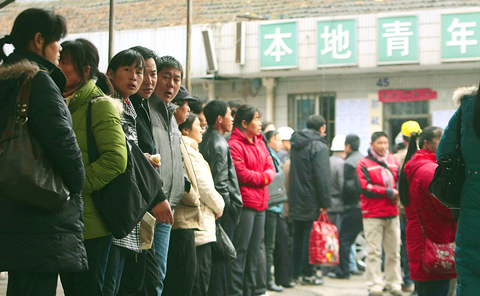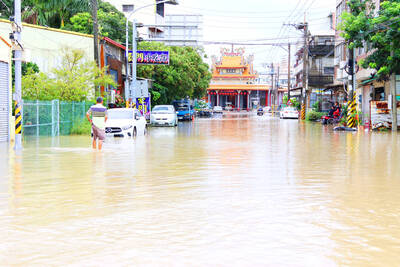China said yesterday that about 20 million rural migrants could not find work because of the global economic crisis, as it admitted mass job lay-offs were heightening concerns about social unrest.
The figure marked a three-fold increase from previous numbers released by the government last month, indicating the slowdown in the world’s third-biggest economy was accelerating and thousands more factories had closed.
“Due to the economic downturn, about 20 million rural migrant workers have either lost their jobs or have not yet found employment and have gone home to the countryside,” Chen Xiwen, a senior rural planning official, told reporters.

PHOTO: AP
“After returning to their village, what do they do about revenue? About their lives? This is a new factor impacting this year’s social stability,” Chen said.
The Chinese Communist Party has long been concerned about the potential for social unrest among its roughly 800 million people who live in the country’s largely poor and polluted countryside.
Before the crisis, about 130 million had left their homes to seek work in more prosperous cities, often finding employment in labor-intensive industries that supplied the world with cheap consumer goods.
But as the global crisis has plunged China’s traditional export markets in Europe and North America into recession, large numbers of workers have lost their jobs as their employers have closed or halted production.
Chen also said that an average of 6 million to 7 million rural dwellers left their homes to find jobs in cities every year, on top of the 20 million jobless workers.
“According to these calculations, there will be fairly big pressure on employment for around 25 million rural residents,” he said.
“So ... ensuring employment and people’s livelihood is ensuring rural stability,” Chen said.
The slowdown in the Chinese economy — which grew just 9 percent last year compared with 13 percent the previous year — has magnified a long-standing problem of a widening wealth divide between China’s cities and countryside.
China’s economic growth slowed to 6.8 percent in the fourth quarter.
The Cabinet on Sunday released a document acknowledging this, as it warned this year would be the “toughest year” since the turn of the century for the development of the countryside, Xinhua news agency said.
Partly to offset the growing problems in the countryside and stimulate rural economies, the Cabinet announced subsidies to all rural residents who bought a wide range of home appliances.
The government has also already announced a number of measures aimed at helping migrant workers who are unable to find jobs, including giving them vocational training and subsidies to set up their own businesses.
The National Bureau of Statistics last month said the number of migrant workers who lost their jobs due to the crisis was about 6 million.
Chen said the 20 million figure was based on a recent agriculture ministry survey carried out in 150 villages in 15 different provinces before the Lunar New Year holiday.
Consumer spending during the Lunar New Year holiday, meanwhile, showed weaker growth than the same period last year as the overall economy slowed, state media reported yesterday.
Consumers spent 290 billion yuan (US$42.4 billion) nationwide during the week-long holiday, the Shanghai Securities News reported, citing the Commerce Ministry.
The figure, up 13.8 percent from the same period last year, remained strong, but slowed down from a 16 percent increase last year, when the country was hit by the worst winter weather in half a century.
The report attributed the holiday surge in consumer spending to aggressive price markdowns by retailers and government efforts to boost domestic demand.

WAITING GAME: The US has so far only offered a ‘best rate tariff,’ which officials assume is about 15 percent, the same as Japan, a person familiar with the matter said Taiwan and the US have completed “technical consultations” regarding tariffs and a finalized rate is expected to be released soon, Executive Yuan spokeswoman Michelle Lee (李慧芝) told a news conference yesterday, as a 90-day pause on US President Donald Trump’s “reciprocal” tariffs is set to expire today. The two countries have reached a “certain degree of consensus” on issues such as tariffs, nontariff trade barriers, trade facilitation, supply chain resilience and economic security, Lee said. They also discussed opportunities for cooperation, investment and procurement, she said. A joint statement is still being negotiated and would be released once the US government has made

NEW GEAR: On top of the new Tien Kung IV air defense missiles, the military is expected to place orders for a new combat vehicle next year for delivery in 2028 Mass production of Tien Kung IV (Sky Bow IV) missiles is expected to start next year, with plans to order 122 pods, the Ministry of National Defense’s (MND) latest list of regulated military material showed. The document said that the armed forces would obtain 46 pods of the air defense missiles next year and 76 pods the year after that. The Tien Kung IV is designed to intercept cruise missiles and ballistic missiles to an altitude of 70km, compared with the 60km maximum altitude achieved by the Missile Segment Enhancement variant of PAC-3 systems. A defense source said yesterday that the number of

Taiwanese exports to the US are to be subject to a 20 percent tariff starting on Thursday next week, according to an executive order signed by US President Donald Trump yesterday. The 20 percent levy was the same as the tariffs imposed on Vietnam, Sri Lanka and Bangladesh by Trump. It was higher than the tariffs imposed on Japan, South Korea and the EU (15 percent), as well as those on the Philippines (19 percent). A Taiwan official with knowledge of the matter said it is a "phased" tariff rate, and negotiations would continue. "Once negotiations conclude, Taiwan will obtain a better

FLOOD RECOVERY: “Post-Typhoon Danas reconstruction special act” is expected to be approved on Thursday, the premier said, adding the flood control in affected areas would be prioritized About 200cm of rainfall fell in parts of southern Taiwan from Monday last week to 9am yesterday, the Central Weather Administration (CWA) said. Kaohsiung’s Taoyuan District (桃源) saw total rainfall of 2,205mm, while Pingtung County’s Sandimen Township (三地門) had 2,060.5mm and Tainan’s Nanhua District (南化) 1,833mm, according to CWA data. Meanwhile, Alishan (阿里山) in Chiayi County saw 1,688mm of accumulated rain and Yunlin County’s Caoling (草嶺) had 1,025mm. The Pingtung County Government said that 831 local residents have been pre-emptively evacuated from mountainous areas. A total of 576 are staying with relatives in low-lying areas, while the other 255 are in shelters. CWA forecaster